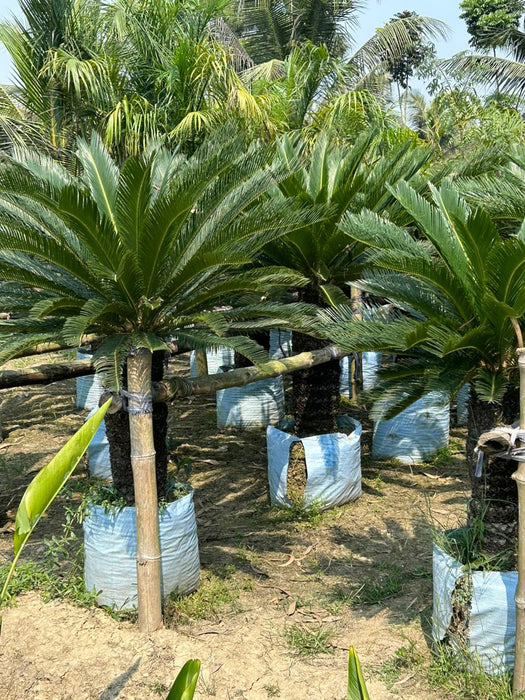
Cycas Palm - Cycas Revoluta
Scientific Name and General Information
The Cycas Palm, scientifically known as Cycas revoluta, is one of the most ancient plant species, often referred to as the Sago Palm. Despite its name, it is not a true palm but belongs to the Cycadaceae family. Native to southern Japan, this plant has a timeless charm, making it a popular choice for gardens and ornamental landscaping worldwide. Renowned for its symmetrical appearance and tough nature, the Cycas Palm is an excellent addition to tropical, subtropical, and even temperate settings.
Physical Description
The Cycas Palm is a slow-growing plant with unique and striking features:
· Height: Typically reaches a height of 1 to 2 meters (3 to 6 feet) but can grow taller in ideal conditions over many years.
· Trunk: Short and stout, resembling a woody cylinder, often surrounded by a crown of old frond bases.
· Leaves: The pinnate, dark green leaves grow in a circular arrangement, radiating symmetrically from the top of the trunk. Each leaf can reach up to 1 meter (3 feet) in length and is stiff with pointed tips.
· Reproductive Cones: The plant is dioecious, meaning male and female cones grow on separate plants. Male plants produce elongated cones, while female plants develop larger, rounded structures.
Cultivation and Growth
The Cycas Palm is hardy and adaptable, making it suitable for a variety of settings:
· Climate: Thrives in warm, sunny climates but can tolerate light frost, making it ideal for USDA zones 8 to 11.
· Soil: Prefers well-drained, sandy or loamy soils. It can also grow in rocky or nutrient-poor soils, showcasing its resilience.
· Watering: Drought-tolerant once established, but young plants require regular watering. Overwatering should be avoided to prevent root rot.
· Propagation: Grown primarily from seeds, which take several months to germinate. Offshoots or pups from mature plants can also be used for propagation.
Uses
Ornamental Landscaping:
o Widely used in gardens, patios, and parks for its symmetrical beauty and tropical look.
o Perfect as a focal point in rock gardens, around water features, or as a potted plant.
Indoor Decoration:
o Smaller specimens are ideal for indoor use, adding elegance and a sense of history to living spaces and offices.
Cultural Significance:
o The Cycas Palm is considered a symbol of longevity and resilience, often featured in traditional Japanese gardens.
Care and Maintenance
The Cycas Palm is low-maintenance but benefits from attentive care:
· Fertilization: Use a slow-release fertilizer rich in micronutrients, especially magnesium and potassium, twice a year.
· Pruning: Remove yellow or dead leaves to maintain a tidy appearance. Avoid over-pruning, as this can stress the plant.
· Pest and Disease Control: The plant is resistant to most pests but may occasionally face scale or mealybug infestations. Treat with insecticidal soap if needed.
Popularity and Distribution
The Cycas Palm is cultivated worldwide due to its adaptability and striking form. It is particularly popular in tropical and subtropical regions, as well as in temperate areas where it is grown as a potted or indoor plant.
Conclusion
The Cycas Palm (Cycas revoluta) is a living fossil that has stood the test of time, bringing a sense of history and beauty to any setting. Its symmetrical fronds, robust nature, and versatility make it a prized choice for gardeners and landscapers. Whether adorning a traditional garden, enhancing a modern landscape, or gracing the interior of a home, the Cycas Palm adds an enduring elegance that never goes out of style.
